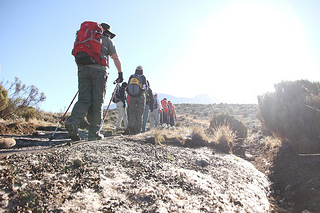
Mount Kilimanjaro with its gleaming glaciers, stands majestically amidst vast open plains, inviting you to the challenge to climb to the “Roof of Africa.” Climbing Mount Kilimanjaro is an experience of a lifetime, highly recommended to the adventurous traveller willing to forego some of life’s luxuries for a few days.
Kilimanjaro stands 330kms south of the equator, on the northern boundary of Tanzania. Its location on an open plain close to the Indian Ocean, and its great size and height strongly influence the climate and thus its vegetation, animal life and climbing conditions.
Kilimanjaro is the highest mountain in Africa composed of three extinct volcanoes: Kibo 5895m (19340ft), Mawenzi 5149m (16896ft), and Shira 3962m (13000ft). It’s the worlds highest free-standing mountain, its bulk looming 4800m above an undulating plain that averages 1000m above sea level. On a clear day, it can be seen from more than 150kms away. Its peak is permanently snow covered, though only 3 degrees below the equator. Kilimanjaro can be climbed by any physically fit person and no climbing experience is necessary.
Climbing Kilimanjaro can be done at any time of the year. There are two rainy seasons – Late March to Mid June and October to November and the best months are January to March and July to October, as the days are usually cloudless. During the day the temperature at 4000m tends to be 15°C and at night, falls to -10°C. At the summit, temperatures are about 5°C during the day and drop to between -18°C and -22°C at night.
Kilimanjaro Climbing Routes
The two most popular climbing routes are the Marangu and Machame Routesboth including porters and guides to accompany each group. Equipment such as sleeping bags, mountain boots, thick sweaters, gloves etc…are required and we can arrange to have this equipment rented and ready for you to use.
The Marangu Route
This climbing route can be undertaken without past mountaineering experience and . accommodation consists of small sleeping huts The Kilimanjaro Central Control Unit has a reliable, equipped rescue team on the Marangu route
7 DAYS & 6 NIGHTS (5 DAYS ON TREK)
Itinerary:
| Day 1 | Transfer from Arusha to Mountain Inn at the base of Mt Kilimanjaro. Overnight. |
| Day 2 | Transfer to the Kilimanjaro National Park Gate at Marangu. Commence climb. Start the climb through fascinating rain forests till you reach the first hut – MANDARA. 2,725m (9,000 ft), 3-4 hours. Meals and overnight at the Mandara hut. |
| Day 3 | After breakfast, follow the ascending path through the alpine meadow.The altitude begins to change and slows down your pace while enjoying the flora and the view of Mawenzi and Kibo peaks.Arrive at the Horombo Hut 12km from Mandara. 3,780m (12,335 ft), 5 hours. Meals and overnight at the Horombo Hut. |
| Day 4 | After breakfast, resume the climb; the landscape becomes rugged and rocky and groundsels and lobelias appear. Climb to Kibo Hut. 4,730m (15,520 ft) 5-6 hours. Meals and overnight at the Kibo Hut. |
| Day 5 | The beginning of the ascent is made at about 3.00am in the morning while the scree is still frozen. Climb the very steep part of the route to GILMAN’s POINT (most difficult and tiring part). 5,680m (18,635 ft) 5 hours. Uhuru peak is reached within an hour’s walk along Crater’s rim. 5,895m (19,344 ft) 1 hour. Start the descent to Horombo Hut for overnight. |
| Day 6 | Descend to the Kilimanjaro National Park gate, from where you are transferred back to your hotel for dinner and overnight. Dinner & Overnight : Mountain Inn |
| Day 7 | After breakfast transfer to Arusha for your next safari destination. |
The Machame Route
This climbing routeis picturesque with a lovely gradual ascent through thick forest emerging upon wide views of the moorland. Machame is less popular than the Marangu Route, but more popular for those who like climbing.
8 Days & 7 Nights (6 DAYS ON TREK)
Itinerary:
| Day 1 | Transfer from Arusha to Mountain Inn at the base of Mt Kilimanjaro. Overnight. |
| Day 2 | Transfer from your hotel to the Kilimanjaro National Park Gate at Machame. From here you trek through the lush forest to Machame Camp 3,000m (10,000ft). Overnight Machame Camp. |
| Day 3 | Leaving the forest, the path follows a steep ridge, passing through heather and open moorlands, and crossing a large gorge to reach Shira Camp 3,800m (12,500ft). Overnight Shira Camp. |
| Day 4 | You turn eastwards and continue ascending through the dry landscape before dropping again to reach Barranco Camp 3,900m (13,000ft). Overnight Barranco Camp |
| Day 5 | The path climbs steeply out of the Barranco Valley, crosses the Karanga Valley, then turns north to reach Barafuu Camp 4,600m (15,500ft). Overnight Barafuu Camp. |
| Day 6 | A long day and an early start to reach the crater rim at Stella Point in time for sunrise. Then to Uhuru Peak 5,896m (19,340ft), the highest point in Africa. Afterwards descend to Mweka/Rau Camp 3,100m (10,300ft). Overnight: Mweka/Rau Camp |
| Day 7 | Descend to the park gate, from where you are transferred back to your hotel. Dinner and overnight at Mountain Inn. |
| Day 8 | After breakfast transfer to Arusha for your next safari destination. |
Equipment to Bring Along for Climbing Mount Kilimanjaro
At least 3 pairs of socks, hiking boots, 2 pairs of trousers, water proof-raincoat and trouser, woollen hat, sun glasses, hand gloves, big rucksack and day pack, sleeping bag & water bottles.
Not Included in the Package
Climbing gear, sleeping bags, items of personal nature, laundry, tips and gratuities, mineral water, drinks & travel insurance.
What is Included
Return transfers from Arusha, 2 nights at base hotel – one night before and 1 after the climb on half board basis, accommodation during the climb, transfers from the hotel to National Park gate and back, climbing fees (Park Fees), porters (2 per person) and guide/s, cook, all meals, climbing fees, hut fees & rescue fees.



